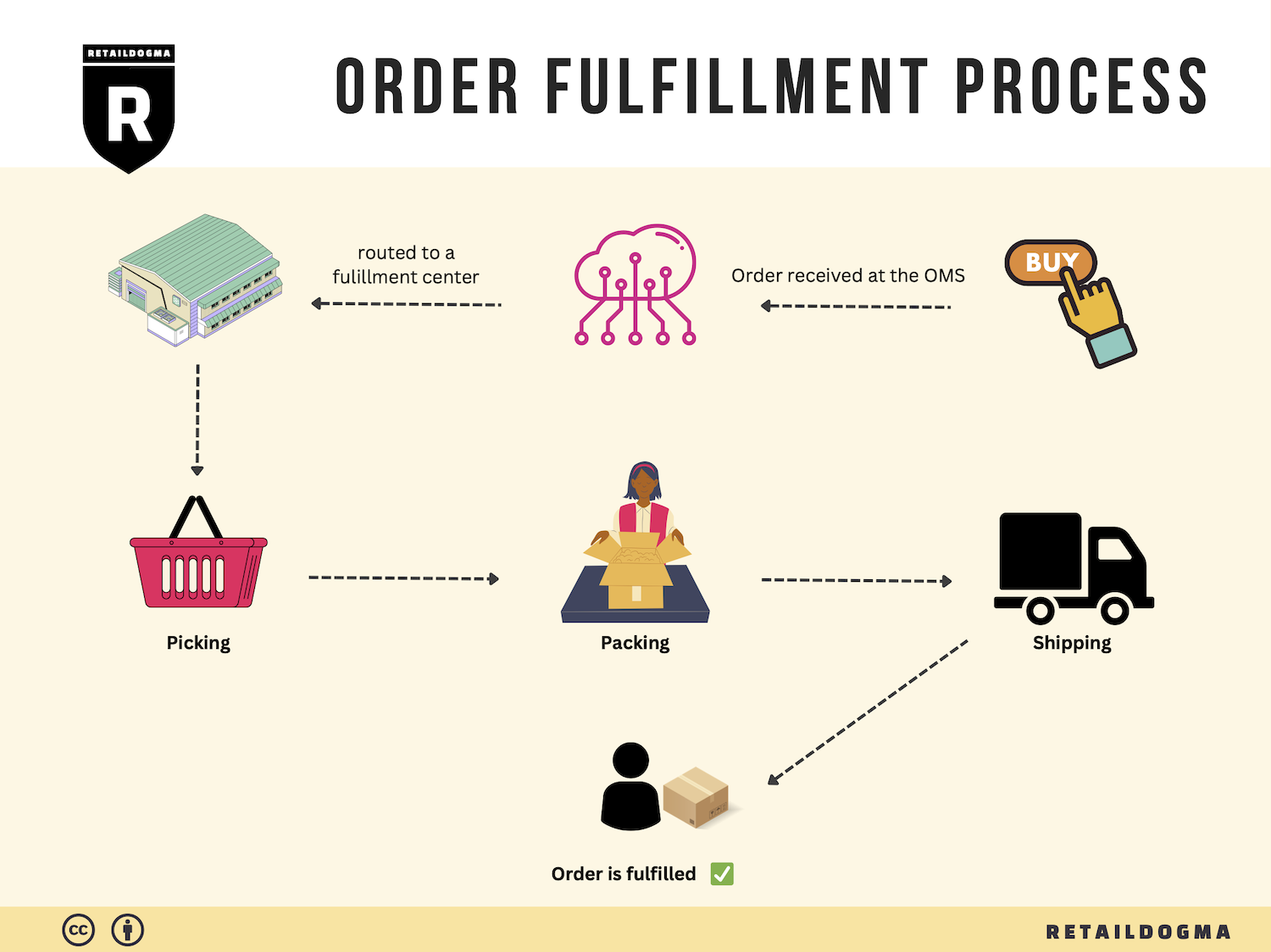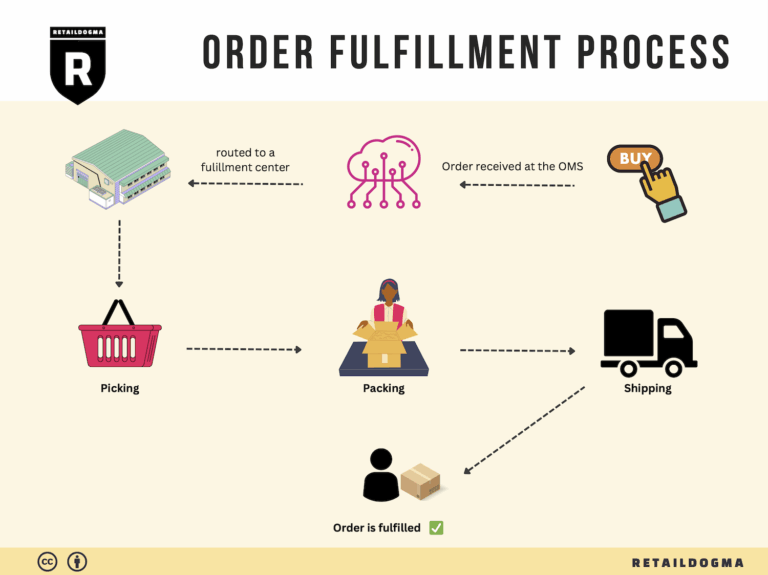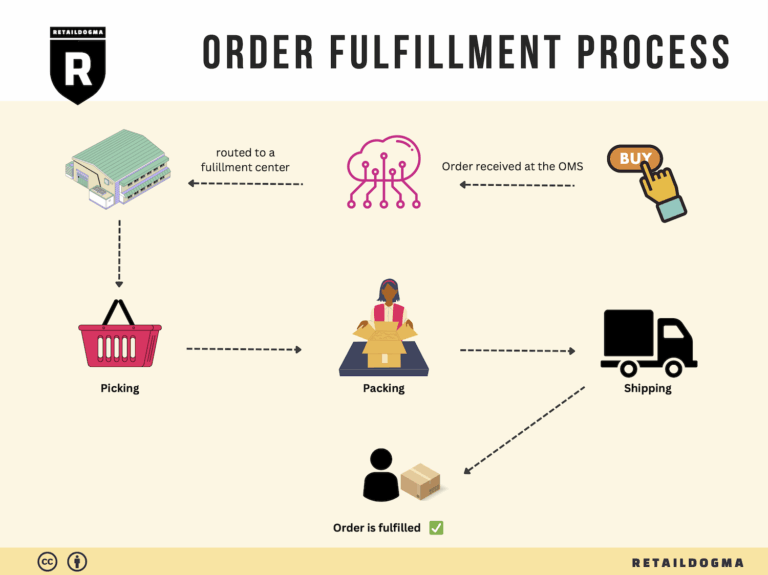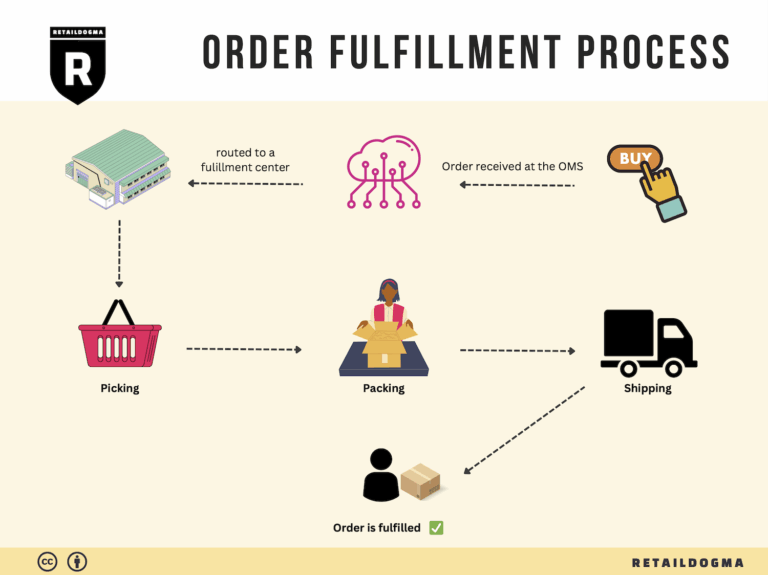What Is A Fulfillment Center? A Complete Guide (2025)
What is E-commerce Fulfillment? An Introduction for Growing Businesses
Understanding the Fulfillment Process
As an e-commerce business owner, one of the most common pain points you may encounter is the overwhelming task of packing and shipping orders. The excitement of growing sales can quickly turn into frustration as you juggle the logistics of getting products from your warehouse to your customers’ doorsteps. This is where e-commerce fulfillment comes into play—a crucial process that encompasses everything involved in delivering a product to a customer after an order is placed.
Fulfillment is not just about shipping; it’s a multifaceted operation that includes inventory management, order processing, packing, and shipping. For growing businesses, mastering this process is essential for maintaining customer satisfaction and scaling operations effectively.
In this guide, we will explore the various fulfillment models available to e-commerce businesses, such as Third-Party Logistics (3PL) and Fulfillment by Amazon (FBA). Each model has its own strengths and weaknesses, and understanding these will help you determine which is the best fit for your business needs.
Additionally, we will delve into the core services that fulfillment centers provide. From inventory storage and order picking to packing and shipping, knowing what to expect from a fulfillment partner is key to making informed decisions.
Choosing the right fulfillment partner can be daunting, especially with so many options available. We’ll discuss the critical factors to consider when evaluating potential partners, including their technology capabilities, shipping speed, and customer service.
Pricing is another vital aspect of fulfillment that can significantly impact your bottom line. We will outline common pricing structures and hidden costs you should be aware of to ensure that your logistics expenses align with your overall business strategy.
Ultimately, this guide aims to empower you with the knowledge needed to make smart decisions about your logistics and fulfillment strategy. By understanding the intricacies of e-commerce fulfillment, you can streamline your operations, enhance customer satisfaction, and position your business for growth in an increasingly competitive market.
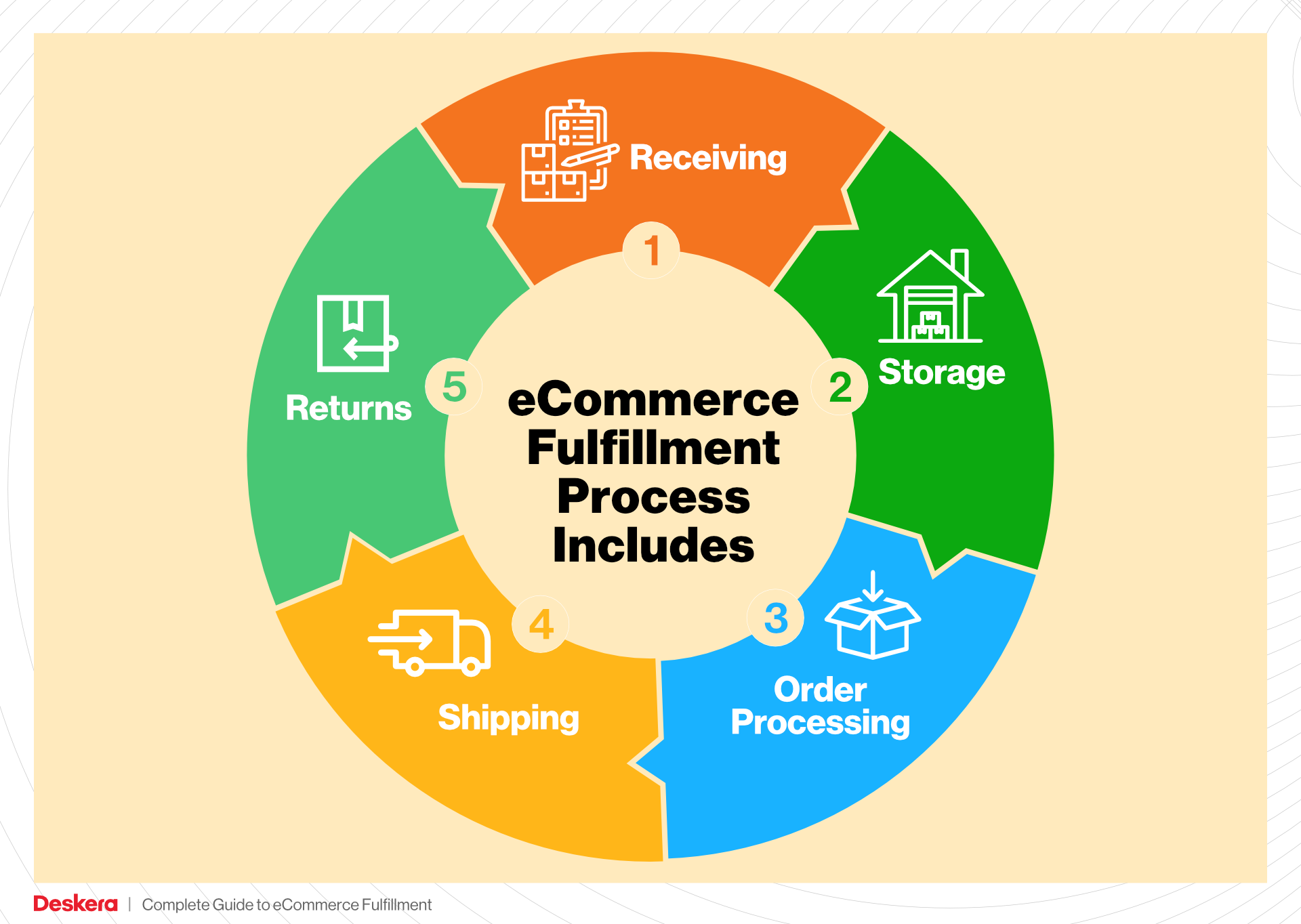
What You’ll Learn In This Guide
- What is E-commerce Fulfillment? An Introduction for Growing Businesses
- The Order Fulfillment Process: From ‘Buy’ Button to Customer’s Door
- Comparing Fulfillment Models: In-House vs. 3PL vs. Dropshipping
- A Deep Dive into Amazon FBA: Pros, Cons, and Who It’s For
- Core Services Offered by Fulfillment Centers
- How to Choose a Fulfillment Partner: A 6-Point Checklist
- Understanding Fulfillment Pricing: A Breakdown of Common Fees
- Frequently Asked Questions (FAQs) about Fulfillment
- Conclusion: Is Outsourcing Fulfillment the Right Move for Your Business?
- Important Disclaimer
The Order Fulfillment Process: From ‘Buy’ Button to Customer’s Door
1. Receiving Inventory
The order fulfillment process begins with receiving inventory at the fulfillment center. Upon arrival, products are unloaded from delivery trucks and checked against purchase orders to ensure accuracy. Each item is assigned a Stock Keeping Unit (SKU), a unique identifier that streamlines tracking and inventory management.
This step is crucial because it sets the foundation for the entire fulfillment operation. Accurate receiving minimizes discrepancies in inventory, which can lead to stockouts or overstock situations. Efficiently managing this step ensures that products are accounted for and ready for subsequent processes. Additionally, implementing automated systems for scanning and tracking can enhance accuracy and speed.
2. Warehouse Storage
After inventory is received and verified, the next step is warehouse storage. Products are organized and placed in designated storage areas based on their SKUs. Modern fulfillment centers, like Amazon’s SAV4, utilize advanced robotics and automated storage solutions to optimize space and streamline retrieval processes.
Proper warehouse storage is essential for maximizing efficiency and minimizing retrieval time during order fulfillment. By categorizing items logically, such as by frequency of sale or size, businesses can facilitate quicker access to products. This not only enhances operational efficiency but also improves the overall customer experience by reducing the time between order placement and dispatch.
3. Order Picking
Once an order is placed by a customer, the next step is order picking. This involves selecting the correct items from storage locations based on a pick list, which details the SKUs and quantities required for each order. In high-tech fulfillment centers, automated systems and robots assist associates in quickly locating and retrieving items.
Order picking is a critical phase in the fulfillment process, as it directly affects order accuracy and speed. The use of pick-to-light systems or mobile devices can significantly enhance picking efficiency, reducing the likelihood of human error. Efficient order picking ensures that customers receive the correct products on time, which is vital for maintaining customer satisfaction and loyalty.
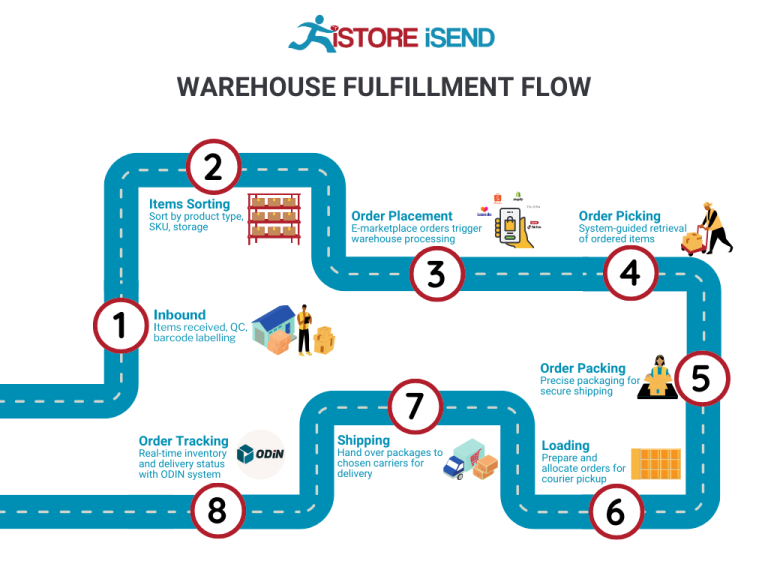
4. Order Packing
After items are picked, they move to the order packing stage. Here, products are carefully packaged for shipment. This step involves selecting appropriate packaging materials, ensuring that items are secure and protected during transit. Packaging must also comply with shipping regulations and reflect the brand’s image, as it often serves as the customer’s first physical interaction with the brand.
The packing process is important for several reasons. First, it protects products from damage, which can lead to costly returns and dissatisfaction. Second, efficient packing minimizes shipping costs by optimizing package size and weight. Finally, it provides an opportunity for branding and marketing, enhancing the overall customer experience. Key considerations during packing include dimensional weight pricing and packaging sustainability.
5. Shipping & Delivery
The final step in the order fulfillment process is shipping and delivery. Once packages are packed, they are labeled and handed over to carriers for transportation. Businesses must choose the most efficient and cost-effective shipping methods, which may include options for expedited shipping based on customer preferences.
This stage is crucial as it determines how quickly and reliably customers receive their orders. Effective shipping and delivery processes can significantly enhance customer satisfaction and influence repeat purchases. Tracking systems are essential here, allowing customers to monitor their orders in real-time, which fosters transparency and trust in the brand.
In summary, a well-structured order fulfillment process—from receiving inventory to shipping and delivery—can greatly enhance operational efficiency, reduce costs, and improve customer satisfaction. By focusing on each step and leveraging technology, businesses can scale their logistics effectively while maintaining high service levels.
Comparing Fulfillment Models: In-House vs. 3PL vs. Dropshipping
Comparison of Fulfillment Models
| Model | Who Handles Inventory | Best For (Business Stage) | Key Advantage | Key Disadvantage |
|---|---|---|---|---|
| In-House Fulfillment | The business itself | Established businesses with stable sales | Full control over inventory and operations | High overhead costs and resource-intensive |
| Third-Party Logistics (3PL) | A third-party provider | Growing businesses scaling operations | Cost-effective and scalable operations | Less control over inventory and fulfillment speed |
| Dropshipping | Suppliers or manufacturers | Startups and small businesses | Low upfront investment and no inventory risk | Lower profit margins and potential quality control issues |
In-House Fulfillment
In-house fulfillment involves a business managing its own inventory and order processing internally. This model is typically best suited for established businesses that have stable sales and a clear understanding of their logistics needs. The primary advantage of in-house fulfillment is the control it provides; businesses can directly manage inventory levels, order accuracy, and customer service, ensuring that brand standards are upheld. Additionally, having direct oversight allows for quicker adjustments to inventory and fulfillment processes based on real-time feedback and performance metrics.
However, this model comes with significant disadvantages. The most notable is the high overhead cost associated with maintaining a warehouse, staffing, and logistics infrastructure. Businesses must invest in facilities, technology, and human resources, which can be particularly burdensome for smaller companies or those experiencing fluctuating sales. Moreover, in-house fulfillment can be resource-intensive, requiring substantial management focus and operational expertise, which may detract from core business activities like marketing or product development.
Third-Party Logistics (3PL)
Third-party logistics (3PL) providers manage the storage, handling, and shipping of products on behalf of businesses. This model is particularly beneficial for growing businesses that need to scale their operations without incurring the heavy costs associated with in-house fulfillment. By partnering with a 3PL provider, businesses can leverage the provider’s expertise, technology, and established networks to streamline their logistics processes.
The key advantage of using a 3PL is cost-effectiveness. Businesses can avoid the capital expenditure of warehousing and equipment, as well as the ongoing costs of staffing and maintaining logistics operations. Furthermore, 3PLs often have access to advanced technology and logistics solutions that can improve efficiency and speed of delivery. However, the downside is that businesses relinquish some control over their inventory and fulfillment processes. This can lead to potential delays in shipping and a lack of visibility into stock levels, which can impact customer satisfaction. Additionally, businesses may face challenges in aligning their operational practices with those of the 3PL provider.
Dropshipping
Dropshipping is a fulfillment model where the retailer does not hold any inventory but instead transfers customer orders and shipment details directly to the supplier or manufacturer. The supplier then ships the products directly to the customer. This model is ideal for startups and small businesses that want to enter the market with minimal upfront investment and no inventory risk.
One of the main advantages of dropshipping is the low barrier to entry; entrepreneurs can start an e-commerce business without significant capital investment in inventory. This flexibility allows businesses to test new products and markets quickly. Additionally, dropshipping eliminates the costs associated with warehousing and logistics management, allowing business owners to focus on marketing and customer acquisition.
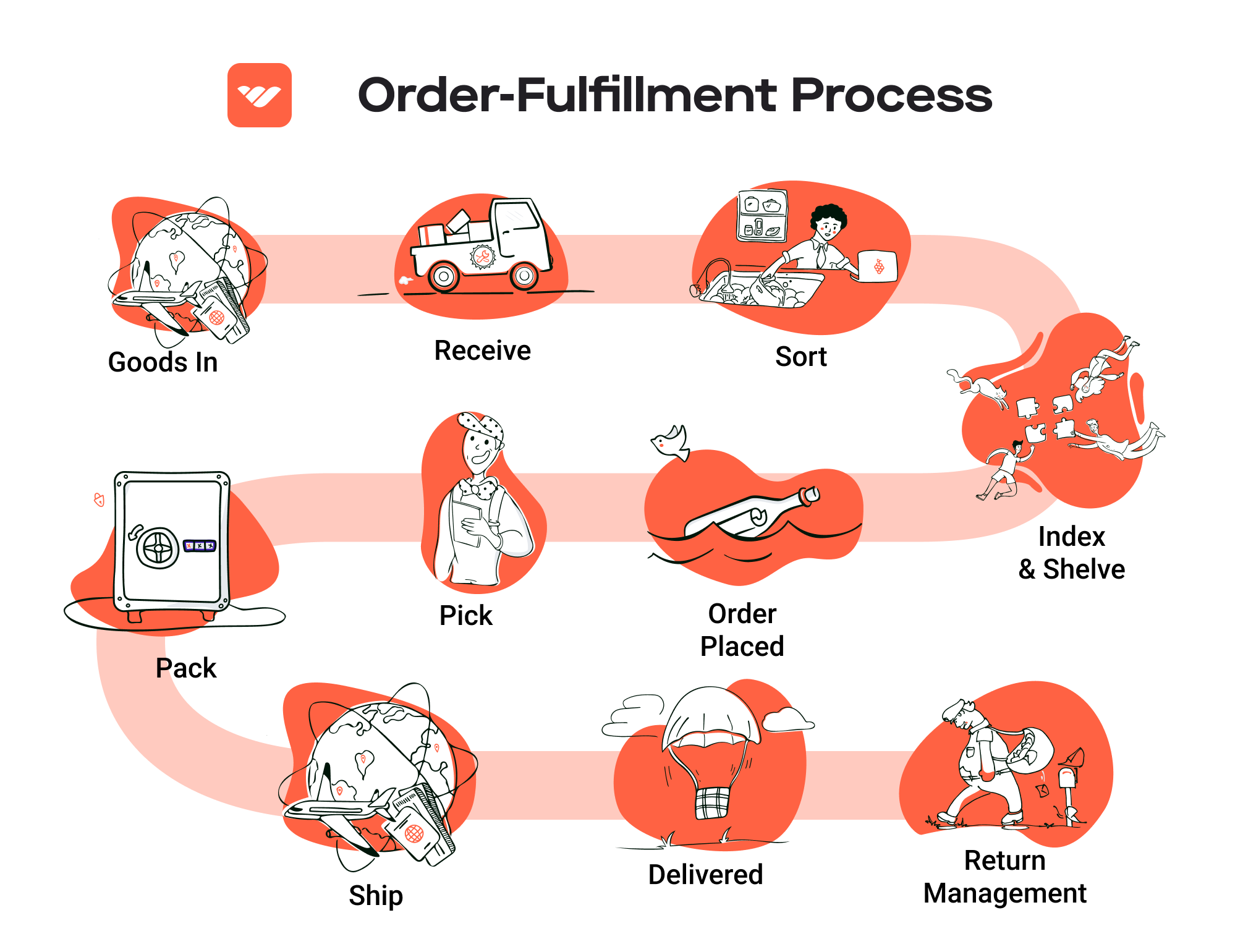
However, dropshipping also has notable disadvantages. Profit margins can be lower compared to in-house fulfillment or 3PL models, as suppliers often charge higher prices for handling and shipping. Moreover, quality control can become an issue, as businesses have limited oversight of the products being shipped and the fulfillment processes employed by their suppliers. This lack of control can lead to inconsistencies in product quality and shipping times, which can negatively affect customer satisfaction and brand reputation.
Conclusion
Choosing the right fulfillment model is a critical decision for e-commerce businesses aiming to scale their operations. Each model—In-House Fulfillment, 3PL, and Dropshipping—offers unique advantages and disadvantages that should align with the company’s current stage, resources, and long-term goals. Understanding these options allows business owners to make informed decisions that can enhance operational efficiency, reduce costs, and improve customer satisfaction as they grow.
A Deep Dive into Amazon FBA: Pros, Cons, and Who It’s For
What is Fulfillment by Amazon (FBA)?
Fulfillment by Amazon (FBA) is a service provided by Amazon that enables sellers to store their products in Amazon’s fulfillment centers. Amazon then takes care of storage, packaging, and shipping of products directly to customers. This service allows sellers to leverage Amazon’s extensive logistics network, ensuring faster shipping times and enhancing the customer experience.
When a customer places an order for a product that is fulfilled by Amazon, the entire process—from picking the product off the shelf to packing it and shipping it—is managed by Amazon. The seller simply needs to focus on sourcing and marketing their products, while Amazon handles the logistics.
How FBA Works
-
Product Setup: Sellers create listings for their products on Amazon and choose the FBA option. They send their products to Amazon’s fulfillment centers, like the newly opened SAV4 in Pooler, Georgia, which is designed for robotic sortation and efficient order fulfillment.
-
Storage: Once the products are received at the fulfillment center, they are stored until an order is placed. Amazon manages the inventory levels and storage conditions.
-
Order Processing: When a customer orders a product, Amazon picks the item from storage, packs it in an Amazon-branded box, and ships it directly to the customer.
-
Customer Service: Amazon also handles all customer inquiries related to shipping and returns, allowing sellers to provide a seamless customer experience.
-
Fees: Sellers are charged fees for using FBA, which include storage fees for the inventory stored in Amazon’s warehouses and fulfillment fees for each order shipped.
Pros of FBA
-
Prime Eligibility: Products fulfilled by Amazon are eligible for Amazon Prime, which can significantly increase sales. Prime members often prefer Prime-eligible products for the benefits of free two-day shipping.
-
Customer Trust: Customers generally trust Amazon’s logistics and customer service. Having products fulfilled by Amazon enhances credibility, as buyers are assured of reliable shipping and easy returns.
-
Multi-Channel Fulfillment: FBA allows sellers to fulfill orders from other sales channels, not just Amazon. This means sellers can use FBA to manage inventory for their own websites or other marketplaces, streamlining logistics across multiple platforms.
-
Scalability: FBA allows businesses to scale quickly without needing to invest heavily in their own warehousing and logistics infrastructure. This is especially beneficial for small to medium-sized businesses that want to grow rapidly.
-
Time Savings: By outsourcing storage, packing, and shipping, sellers can focus on their core business activities, such as product development and marketing, rather than logistics.
Cons of FBA
-
High Fees: While FBA offers numerous benefits, the costs can accumulate quickly. Sellers face various fees, including storage fees (which can vary based on the time of year) and fulfillment fees for each item shipped. These costs can significantly impact profit margins, especially for low-cost products.
-
Strict Inventory Rules: Amazon has strict guidelines regarding inventory management, including how much inventory can be stored and how long it can remain in their warehouses. Sellers may incur additional charges for long-term storage if items do not sell quickly.
-
Commingling Risks: FBA products may be commingled with inventory from other sellers, which can lead to issues if there are quality concerns or defects. This means that sellers could unknowingly ship a defective product if it’s mixed with their inventory.
-
Limited Control: By using FBA, sellers relinquish a degree of control over their inventory and shipping processes. Any issues with Amazon’s fulfillment network—such as delays or errors—can directly affect the seller’s business reputation.
-
Complex Returns Management: While Amazon manages returns, this can sometimes lead to complications for sellers, particularly if items are returned damaged or in unsellable condition. Sellers may face challenges in recovering costs for returned items.
Who is FBA Best For?
Fulfillment by Amazon is particularly advantageous for:
-
Small to Medium-Sized Sellers: Businesses that lack the resources to manage their own logistics can benefit from FBA’s infrastructure without the need for significant capital investment.
-
High-Volume Sellers: Sellers with a large number of transactions can leverage FBA to streamline operations, ensuring that orders are fulfilled quickly and efficiently.
-
Brands Seeking to Scale: For brands looking to expand their reach, FBA provides a ready-made logistics solution that allows for rapid growth without the need for additional warehousing.
-
Multi-Channel Sellers: Those who sell on multiple platforms can benefit from FBA’s multi-channel fulfillment capabilities, allowing them to manage inventory more efficiently.
-
New Entrants to E-commerce: For entrepreneurs just starting out, FBA provides a low-risk entry point into e-commerce, allowing them to focus on marketing and sales rather than logistics.
In summary, FBA can be an excellent choice for e-commerce businesses looking to scale efficiently, but it’s essential to weigh the pros and cons carefully to determine if it aligns with your business model and goals.
Core Services Offered by Fulfillment Centers
Inventory Management & Warehousing
Effective inventory management and warehousing are foundational services provided by fulfillment centers. These centers utilize advanced technology and streamlined processes to ensure that products are accurately tracked, stored, and managed throughout their lifecycle.
At a fulfillment center, inventory management involves real-time tracking of stock levels, automated inventory audits, and precise forecasting to avoid stockouts and overstock situations. This is particularly beneficial for e-commerce businesses that require agility in their supply chain. With tools like RFID tagging and barcode scanning, fulfillment centers can maintain high accuracy in inventory counts, which reduces the risk of errors that can lead to lost sales or excess costs.
The benefits of robust inventory management extend beyond mere tracking. By optimizing storage space and ensuring efficient retrieval methods, fulfillment centers can significantly reduce the time it takes to locate and ship products. This speed not only enhances customer satisfaction due to quicker delivery times but also allows businesses to scale operations without the need for substantial investments in their own warehousing infrastructure.
Pick and Pack Services
Pick and pack services are essential for e-commerce businesses looking to efficiently fulfill customer orders. This service involves the picking of items from inventory based on customer orders and then packing them for shipment. Fulfillment centers employ a combination of manual labor and automated systems, such as robotic pickers and conveyor belts, to streamline this process.
When an order is placed, fulfillment center associates quickly locate the requested items from the warehouse shelves, ensuring that they are in good condition before packing. The packing process is equally critical; items are carefully packed to minimize damage during transit, often using custom-sized boxes and protective materials to ensure safe delivery.
The primary benefit of pick and pack services is the speed and accuracy with which orders are fulfilled. In a competitive e-commerce landscape, customers expect fast shipping and accurate order fulfillment. By outsourcing these services to a fulfillment center, businesses can leverage the center’s expertise and technology to improve their order processing times, thereby enhancing customer satisfaction and loyalty.
Kitting and Assembly
Kitting and assembly services offered by fulfillment centers allow e-commerce businesses to streamline the process of preparing products for sale. Kitting involves grouping various items together into a single package, while assembly refers to putting together multiple components to create a final product. These services are particularly advantageous for businesses that sell products requiring assembly or those looking to offer bundled deals.
For example, a company selling a children’s toy set may choose to kit several toys together into a single package, providing added value to customers. Similarly, a furniture retailer might use assembly services to pre-assemble items before shipment, saving the customer time and effort upon delivery.
The benefits of kitting and assembly services are manifold. They help reduce the complexity of inventory management by consolidating multiple SKUs into a single item, which can simplify the pick and pack process. Additionally, these services can enhance the customer experience by providing ready-to-use products, ultimately leading to increased sales and customer satisfaction.
Returns Management (Reverse Logistics)
Returns management, or reverse logistics, is a critical service offered by fulfillment centers that can significantly impact customer satisfaction and business efficiency. This service encompasses the processes involved in handling returned items, including receiving, inspecting, restocking, and, if necessary, disposing of products.
In the e-commerce world, where customers often expect hassle-free return policies, effective returns management is essential. Fulfillment centers provide a streamlined approach to handling returns, ensuring that they are processed quickly and accurately. They utilize tracking systems to monitor returns, which helps businesses understand return rates and identify potential issues with specific products.
The benefits of efficient returns management are twofold. First, it enhances customer trust and loyalty, as consumers appreciate a straightforward return process. Second, it allows businesses to recapture value from returned items, either by restocking them for resale or repurposing them in other ways. This capability is particularly important in a market where maintaining a positive brand reputation is vital for long-term success.
In conclusion, fulfillment centers offer a suite of core services that are essential for e-commerce businesses aiming to scale efficiently. By leveraging these services—inventory management and warehousing, pick and pack services, kitting and assembly, and returns management—businesses can enhance operational efficiency, improve customer satisfaction, and ultimately drive sales growth.
How to Choose a Fulfillment Partner: A 6-Point Checklist
Location & Warehouse Network
Importance:
The geographical location of your fulfillment partner’s warehouses can significantly affect shipping times and costs. A partner with warehouses strategically located near your customer base can help reduce delivery times and shipping expenses, enhancing customer satisfaction.
Questions to Ask:
– Where are your warehouses located, and how does this align with my target market?
– What is your average shipping time to key regions?
– Do you have a network of warehouses that can scale as my business grows?
Technology & Integrations
Importance:
In today’s fast-paced e-commerce environment, technology is critical for efficient operations. A partner that utilizes advanced fulfillment technology can streamline order processing, inventory management, and shipping, while seamless integrations with your existing platforms (like your e-commerce store) can improve operational efficiency.
Questions to Ask:
– What technology platforms do you use for order management, inventory tracking, and shipping?
– Can your system integrate with my e-commerce platform and other tools I currently use?
– How do you ensure data accuracy and minimize errors in order fulfillment?
Specializations (e.g., cold storage, oversized items)
Importance:
Not all fulfillment centers are equipped to handle specific types of products, such as perishables or oversized items. Understanding your product requirements and ensuring your fulfillment partner can meet them is essential to maintaining product quality and compliance with regulations.
Questions to Ask:
– Do you have specific facilities or capabilities for specialized products (e.g., cold storage, hazardous materials)?
– What is your experience in handling my type of products?
– How do you ensure compliance with industry standards and regulations for specialized items?
Scalability & Capacity
Importance:
As your business grows, your fulfillment needs will evolve. A good partner should be able to scale operations to accommodate increased order volumes, seasonal spikes, or new product lines without compromising service quality.
Questions to Ask:
– How do you handle fluctuations in order volume, such as seasonal spikes?
– What is your maximum storage capacity, and how quickly can you scale if needed?
– Can you provide examples of how you have successfully scaled for other clients in the past?
Pricing and Contracts
Importance:
Understanding pricing structures and contract terms is crucial to maintaining profitability. Transparent pricing helps you budget effectively, while favorable contract terms can provide flexibility as your business needs change.
Questions to Ask:
– Can you provide a detailed breakdown of your pricing structure (e.g., storage fees, pick-and-pack fees, shipping costs)?
– Are there any additional fees I should be aware of (e.g., for returns or special handling)?
– What are the terms of the contract, and is there flexibility for renegotiation as my business grows?
Customer Support & Reviews
Importance:
Reliable customer support is essential for resolving issues quickly and maintaining operational continuity. Additionally, reviews and testimonials from other clients can provide insight into the fulfillment partner’s reliability and service quality.
Questions to Ask:
– What kind of customer support do you offer (e.g., dedicated account manager, 24/7 support)?
– Can you provide references or testimonials from similar businesses?
– How do you handle issues or delays in order fulfillment, and what is the typical response time?
Conclusion
Choosing the right fulfillment partner can make or break your e-commerce business. By carefully evaluating potential partners based on the criteria outlined in this checklist, you can find a 3PL provider that aligns with your operational needs, supports your growth, and ultimately enhances your customer experience. Always conduct thorough due diligence, ask pointed questions, and consider seeking feedback from current or past clients to ensure you make an informed decision.
Understanding Fulfillment Pricing: A Breakdown of Common Fees
Initial Setup Fees
Initial setup fees are one-time charges incurred when you first engage with a fulfillment service. These fees cover the costs associated with establishing your account, integrating your systems, and configuring your product listings. The setup process may include creating an inventory management system, setting up your shipping preferences, and implementing any necessary software integrations.
The calculation of initial setup fees can vary widely based on the complexity of your e-commerce operation. Factors such as the number of SKUs (Stock Keeping Units) you plan to manage, the level of customization required for your integration, and whether you require additional services (like branding or special packaging) can influence the total cost. Expect to see fees ranging from a few hundred to several thousand dollars, depending on your specific needs and the fulfillment partner’s pricing structure.
Receiving Fees
Receiving fees are charged when your inventory arrives at the fulfillment center. This fee covers the labor and equipment costs associated with unloading, inspecting, and storing your products.
Typically, receiving fees are calculated on a per-pallet or per-box basis. For example, if your shipment consists of 20 pallets, and the receiving fee is $25 per pallet, your total receiving fee would amount to $500. It’s crucial to note that any discrepancies in the received quantity or damages may lead to additional handling charges. Therefore, ensuring accurate shipments can help mitigate unexpected costs.
Storage Fees (per pallet/bin)
Storage fees are ongoing charges applied for the space your inventory occupies in the fulfillment center. These fees are typically calculated on a monthly basis and can be determined either per pallet, per bin, or by cubic foot, depending on how the fulfillment center manages its inventory.
For instance, if your products are stored in pallets and the storage fee is $10 per pallet per month, and you have 10 pallets, your monthly storage fee would be $100. It’s important to monitor your inventory levels, as excessive storage can lead to higher costs, especially during peak seasons when many businesses scale their operations. Additionally, some fulfillment centers may implement long-term storage fees for items that remain in their facility for extended periods (usually beyond six months), which can further impact your bottom line.
Pick & Pack Fees (per item/order)
Pick and pack fees are incurred each time an order is processed. This charge covers the labor involved in retrieving items from storage, packing them appropriately, and preparing them for shipment.
Typically, pick and pack fees are calculated on a per-item or per-order basis. For example, if the fee is $2 per item and a customer orders three items, the pick and pack fee would be $6. Some fulfillment centers may also charge a base fee per order, plus additional fees per item, which can significantly affect your overall fulfillment costs, especially for smaller orders with multiple items. Understanding your order patterns can help you estimate these fees more accurately.
Shipping Fees
Shipping fees are among the most significant costs in the fulfillment process and can vary based on several factors, including the shipping method, destination, package weight, and dimensions. Fulfillment centers often negotiate shipping rates with carriers and may pass some of these savings on to their clients.
Shipping fees are typically calculated based on a combination of weight and distance. For instance, a 5-pound package shipped to a nearby state may cost significantly less than the same package sent across the country. Additionally, many fulfillment centers offer tiered shipping rates that can provide discounts for higher volumes or specific service levels, such as expedited shipping.
Tips for Getting an Accurate Quote
-
Be Transparent: When seeking quotes from fulfillment centers, provide detailed information about your products, order volume, and specific requirements. The more information they have, the more accurate their estimates will be.
-
Understand Your Needs: Clearly define your operational needs, including peak seasons, storage requirements, and shipping preferences. This can help fulfillment centers tailor their quotes to your business.
-
Request a Breakdown: Ask for a detailed breakdown of all potential fees, including any variable charges based on your specific operations. This transparency will help you avoid unexpected costs.
-
Compare Multiple Providers: Don’t settle for the first quote you receive. Compare pricing and services from multiple fulfillment centers to ensure you’re getting the best value for your needs.
-
Consider Long-Term Costs: Look beyond initial fees and consider the long-term costs associated with storage, pick and pack, and shipping fees. An initially low setup fee could lead to higher ongoing costs.
By understanding these common fulfillment pricing models and following these tips, you can make more informed decisions as you scale your e-commerce business, ensuring that your fulfillment strategy aligns with your operational goals and budget.
Frequently Asked Questions (FAQs) about Fulfillment
1. What is the Amazon Fulfillment Center SAV4?
The Amazon Fulfillment Center SAV4 is a state-of-the-art facility located in Pooler, Georgia, designed to enhance Amazon’s logistics capabilities. Opened in August 2023, this 2.9 million square foot center utilizes advanced robotics for sorting and fulfillment processes, enabling rapid order processing and delivery.
2. How does the SAV4 fulfillment center utilize robotics?
SAV4 employs various robotic systems to streamline operations. These robots are responsible for transporting goods throughout the facility, sorting items, and preparing them for shipment. The use of robotics allows for increased efficiency, reduces human error, and enhances overall throughput.
3. What is the difference between a warehouse and a fulfillment center?
A warehouse is primarily a storage facility where goods are held until they are needed. In contrast, a fulfillment center is designed for the complete order processing cycle, including storage, picking, packing, and shipping. Fulfillment centers focus on speed and efficiency to meet customer demands, particularly for e-commerce businesses.
4. What is a 3PL (Third-Party Logistics)?
A 3PL, or Third-Party Logistics provider, is a company that offers outsourced logistics services, including warehousing, transportation, and order fulfillment. Businesses often partner with 3PLs like Amazon to leverage their expertise and infrastructure, allowing them to scale operations without heavy investment in logistics capabilities.
5. How much do fulfillment services cost at Amazon SAV4?
Fulfillment costs at Amazon can vary based on several factors, including the size and weight of products, order volume, and specific services required. Typically, fees are structured around storage, pick and pack, and shipping. For precise pricing, businesses should refer to Amazon’s FBA (Fulfillment by Amazon) fee structure or consult directly with Amazon’s support.
6. What types of products can be fulfilled at the SAV4 center?
The SAV4 fulfillment center can handle a wide range of products, including electronics, household items, toys, clothing, and more. However, some items may be restricted or require special handling. It’s essential for sellers to review Amazon’s guidelines to ensure compliance.
7. How does the order fulfillment process work at SAV4?
The order fulfillment process at SAV4 begins with the receipt of customer orders. Items are picked from storage, packed into shipping boxes, and labeled for delivery. The facility’s advanced conveyor systems and robotics facilitate the movement and sorting of products, ensuring quick processing times.
8. What are the benefits of using Amazon SAV4 for my e-commerce business?
Utilizing Amazon SAV4 offers several advantages, including access to Amazon’s extensive logistics network, faster delivery times, improved inventory management, and reduced operational costs. This can lead to enhanced customer satisfaction and increased sales potential for e-commerce businesses.
9. Can I track my inventory and orders at the SAV4 center?
Yes, Amazon provides comprehensive tracking tools for inventory and orders processed through its fulfillment centers. Sellers can access real-time data on stock levels, order statuses, and shipping information through the Amazon Seller Central platform.
10. How can I get started with using Amazon’s fulfillment services?
To start using Amazon’s fulfillment services, businesses need to create an Amazon seller account and enroll in the Fulfillment by Amazon (FBA) program. From there, sellers can list their products, ship inventory to the fulfillment center, and begin leveraging Amazon’s logistics capabilities for order fulfillment.
Conclusion: Is Outsourcing Fulfillment the Right Move for Your Business?
The Strategic Advantage of Outsourcing Fulfillment
In today’s competitive e-commerce landscape, outsourcing fulfillment can be a game-changer for your business. By partnering with a dedicated fulfillment service, you can save invaluable time that can be redirected towards strategic initiatives such as marketing and product development. The automation and streamlined processes employed by fulfillment centers, like Amazon’s SAV4, enable businesses to manage inventory and orders efficiently, minimizing the risk of errors and delays.
Moreover, scalability is a significant advantage of outsourcing fulfillment. As your sales grow, so too do the complexities of order management and logistics. A reliable fulfillment partner can easily adapt to your changing needs, whether you’re experiencing seasonal spikes in demand or launching new products. This flexibility allows you to focus on core business activities without the burden of constantly adjusting your operational capacity.
Expertise is another crucial benefit. Fulfillment centers possess specialized knowledge in logistics, inventory management, and shipping regulations. This expertise not only enhances operational efficiency but also improves customer satisfaction through faster and more reliable shipping options.
However, the success of outsourcing fulfillment hinges on selecting the right partner. It’s essential to evaluate potential fulfillment providers based on their technology, infrastructure, and service offerings to ensure they align with your business goals and growth trajectory.
As you contemplate this strategic move, consider conducting a thorough audit of your current shipping process. Assess where you can improve efficiency, reduce costs, and enhance customer experience. If you find that your in-house logistics are becoming a bottleneck, it may be time to explore fulfillment partnerships that can propel your business to the next level. Take the first step towards streamlined operations today—your growth potential awaits.
Important Disclaimer
⚠️ Important Disclaimer
The information in this guide is for educational purposes. Fulfillment services, pricing, and platform features change frequently. Always conduct your own due diligence and consult with providers directly before making business decisions.
